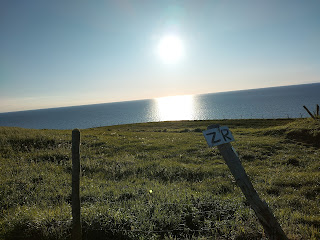On a second summer time birding trip to northern France, slightly earlier in the year than 2023. Heading off on the 09:30 ferry from Newhaven to Dieppe, we saw one great skua about 8 miles offshore of Beachy head.
The first evening saw a corn bunting in clifftop grassland close to the west of Ault. Black redstart is a common bird in the town, with at least five singing males, and several females seen. A building with missing windows was visited by a tail-shimmering female, with a male nearby.
 |
| Clifftop grassland west of Ault |
On a couple of day trips to Crécy Forest, the avian highlights included two honey-buzzard, three melodious warblers and four short-toed treecreeper. Chaffinch, chiffchaff, and willow warbler were all very abundant, with best part of a thousand birds from these species heard or seen across the large woodland parcel. The first visit we walked down from Regnière-Écluse, which included a nice area of wetland at the entrance with lots of sedge warblers. On a eight hour loop we picked up seven tree pipits favouring the cleared areas, at least 20 garden warblers in the scrubland shrub layer which outnumbered the blackcaps, and also yellowhammer. Whilst having lunch in a clearing we had a couple of hawfinches flyover. Generally the birding here was tough going with birds not showing for long.
The second visit we walked closer to the edge of the forest, with a theory that some open sky would encourage more prolonged views. For this we parked on the D111, which reduced walking time to the core sections of the forest. We were rewarded with the honey-buzzards, treecreeper sp. individuals which were then identified as short-toed from song. Melodious warbler were favouring the areas of broom in open areas. A couple of marsh tits were seen. Another hawfinch was foraging on beech mast. Beech and oak were the predominant tree species seen in the sections of forest walked.
 |
| Solomon's seal in the woodland ground flora |
 |
| Melodious warbler |
 |
| Melodious warbler |
On the way back, we picked up some easy to see wetland birds at Aire de covoiturage de Noyelles-sur-Mer. A white stork was seen near to a convenient parking location. The wetland area to the south of here also looks promising habitat.
On a rainy morning we visited the hides of Park Marquenterre. Expectations were not too high, with main objectives to be not to get drenched. There was a 12 euro entrance fee, however it proved to be a great bird reserve with high quality wetland and woodland habitat. The layout of the site meant the birds were protected well from disturbance even with high visitor numbers.
We had a crested tit twice briefly, in trees whilst overlooking the stork nesting area. Also heard a golden oriole singing from the poplars in this area. Other highlights from this site included a garganey, glossy ibis, two greenshanks, two bar-tailed godwits, black-tailed godwits, a pair of black-necked grebe, a sanderling in summer plumage, about seven common sandpipers, and the nesting colony including spoonbills, cattle egrets, and white storks. Also at least three singing nightingale. Night herons also nest here, but were not seen.
 |
Nesting white storks at Park Marquenterre | | Common sandpiper |
 | | Black-necked grebes |
|  | | Drake garganey |
|
|
|
We visited Noyelles-sur-Mer to view the reedbed at Renclôture Elluin from the footpath. Here were recorded five bluethroats, seven savi's warblers, two hobbies, white storks, and three bearded tits. A zitting cisticola was seen not heard. Near the train line we heard purring turtle dove and had a loud singing nightingale. A marsh harrier was seen in flight. Yellow wagtail is clearly an abundant bird here during the breeding season, with great views of many, and quail was heard singing.
.jpg) |
| Bluethroat |
 |
| Savi's warbler |
 |
Yellow wagtail
|
 |
Yellow wagtail
|
 |
Some culture in the form of a steam train
|
Hable d'Ault was visited one afternoon. We walked up from Cayeux-sur-Mer as thought it may be quicker than from Ault side but the scrape turned out to be more or less central. You could perhaps drive along a loose stone track to reduce walking time. Here we saw black-winged stilts, kentish plovers, little ringed plovers and ringed plovers. Pleasant to see were also three wheatear along the bund and a charcoal male black redstart on a garage.
 |
| Hable d'Ault |
On the final evening we visited a marshy grassland with reeds and open water, close to the south of Ponthoile. Parking was available on the rte de nouvion. Walking down the paths, we had five bluethroats, one singing marsh warbler, two little ringed plover, great views of zitting cisticola, as well as cuckoo and black-tailed godwits. The wildflower diversity in this area was excellent. The wetland appears to extend further eastwards to Sailly Bray so it could no doubt hold more birds.
.jpg) |
| Marshy grassland south of Ponthoile |
 |
| Marsh lousewort |
 |
| Bluethroats |
On the ferry back from Dieppe to Newhaven, we had about 15 distant knot near the coast. Further out in the channel we saw two great skuas, a black tern, three swallows, and nine whimbrel. Joined by the ORCA cetacean monitoring team on the deck we saw several harbour porpoises, a grey seal as well as the treat of a small pod of bottlenose dolphin.
 |
Great skua | | Great skua |
|





.jpg)





.jpg)









Comments
Post a Comment